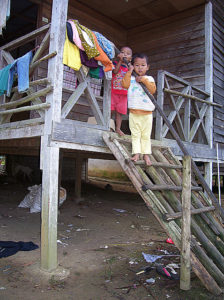A news story in 2008 described a number of reasons for the relative lack of success by the Malaysian schools in educating their Orang Asli children. A current report brings the analysis up to date by concentrating on one of the major problems: cultural differences.

Cultural differences between the Orang Asli and the majority of Malaysians make it difficult for some of the children from the minority communities to understand basic facts and concepts described in their textbooks. A teacher in an English class in a Semai community has been dealing with this problem by focusing on the folklore of the people. He is using creative ways to engage the children in the rich traditions of the Semai to gradually introduce English into their lives.
The teacher, Zainul Hakim Shazni, who teaches English in Sungai Koyan, a Semai village in Kuala Lipis, in the Malaysian state of Pahang, found that the children were having an especially hard time understanding their textbooks. He was quoted in The Sun newspaper as saying, “There is nothing wrong with the books but for the Semai children, the origins and context of the stories are foreign and they cannot relate to it.” As a result, many students lack even the most basic facility in the use of English.
His creative energies fired up, the teacher formed a group of his students to help him put together a listing of Semai folk tales. They studied them and narrowed the list to two tales. The first, titled “Paya Jalil,” describes a group of children who are eaten up by a swamp for making fun of animals.
The second story they chose, “Bah Luj and Tabarok,” is about a child, Bah Luj, who failed in his duty to watch over his younger brother while his parents were away. When Bah Luj temporarily leaves, Tabarok, a horrifying monster, comes in and kills the little brother. Bah Luj settles the score by coming out from his own hiding place and killing the monster.
Zainul encouraged the children to get their parents to retell these folktales at home in the Semai language. Then, in school, the kids retold the stories in English. They made story boards to help dramatize the tales and then used video editing apps to compile the story boards into videos of the chosen folktales. They played the videos in class—with the stories, of course, narrated in English.
The teacher told the newspaper reporter that the Semai have customs relating to the telling of folktales, which they follow in the classroom. The Semai recite incantations before telling some of the folktales, so the teacher and his students will do the same in class, if custom prescribes them to. Some stories are only told at certain times of the day, another custom followed by the class.
While Zainul is clearly a very creative teacher, it is probably too soon to evaluate the success of his approach. Are his methods prompting better learning by the Semai students?